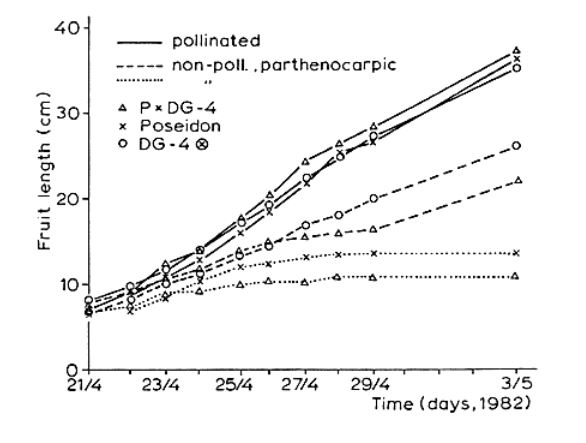Cucurbit Genetics Cooperative Report 6:84-85 (article 42) 1983
A. P. M. den Nijs and J. Balder
Institute for Horticultural Plant Breeding, P. O. Box 16, Wageningen, The Netherlands
Large differences in parthenocarpic fruit set amongst zucchini squash cultivars were reported (1). Selection for parthenocarpy was successful and a breeding line with high tendency to parthenocarpic fruit set under Dutch early spring glasshouse conditions was offered to interested breeders.
Three progenies of this line were evaluated in a spring trial in 1982. The plants were transplanted March 8 in an insect-free glasshouse with approximately 23°C days and 12°C nights nights in 3–7 replicated of 5 plants each, and parthenocarpic fruit production was measured until the end of April. Some results are in Table 1.
Table 1. Parthenocarpic fruit set of zucchini squash in the glasshouse (1982).
Population |
Number of plants |
Percentage fruit set |
Numbers of fruit per plant |
Yield (g) per plant |
Percentage class 1 fruit |
|
DG-4 |
25 |
87 |
4.4 |
1152 |
58 |
|
DG-4 x |
35 |
77 |
4.7 |
1219 |
58 |
|
Poseidon |
15 |
51 |
2.5 |
706 |
43 |
|
Poseidon x DG-4 |
25 |
50 |
2.3 |
618 |
48 |
|
Elite |
15 |
17 |
1.4 |
306 |
19 |
Three levels of parthenocarpy can be distinguished. Lines DG-4 and DG-4 x represent the highest level, both for percentage fruit set, mean number of fruits per plant in the first three weeks of harvest, fruit yield, and percentage of fruits in class 1 (normal shaped, regular sized fruits). The figures listed for DG-4 x are the means of three separate inbred lines which behaved similarly. Apparently, further selection for parthenocarpy has not had success. Standard cv. Elite (commonly grown in the Netherlands) had a very low level for all four parameters listed in the table. The percentage fruit set was higher this year than in last year’s trial for all cvs. The ranking of cvs. remained the same. The high light intensity of this spring may have contributed to the good fruit set.
The hybrid progeny Poseidon x DG-4 behaved similarly to ‘Poseidon’ with respect to parthenocarpy, although it was intermediate for other plant and fruit characters. We consider this as preliminary evidence that the high level of parthenocarpy in DG-4 is a recessively inherited character. More advanced progenies are being tested to answer this question.
Towards the end of the trial a number of female flowers of several genotypes were hand-pollinated and the length of developing fruits was measured daily for 8 days, and one more time after 12 days. Simultaneously non-pollinated parthenocarpic (developing) and non-parthenocarpic fruitlets of the same lines were also measured. Some results are in Figure 1.
Figure 1. Mean length growth of pollinated and non-pollinated flowers of squash.
Figure 1 presents preliminary data on the length growth of pollinated and nonpollinated ovaries of 3 genotypes in this study. Each line is based on only 2–4 fruits. The growth of parthenocarpic fruits of DG-4 x approximated 1.6 cm/day during the first 8 days. The pollinated fruits of all genotypes grew about equally fast at approximately 2.4 cm/day. Both fruit types did not stop growing even after 12 days. Non-parthenocarpic fruits elongated slightly before rotting away. It appears, then, that parthenocarpic fruits make indeed a less rigorous harvesting schedule possible. A yield comparison of pollinated and parthenocarpic producing plants is planned.
Literature Cited
- Nijs, A.P.M. den, and N.J.D. Veldhuyzen van Zanten. 1982. Parthenocarpic fruit set in glasshouse grown zucchini squash. Cucurbit Genetics Coop. Rpt. 5:44–45.
